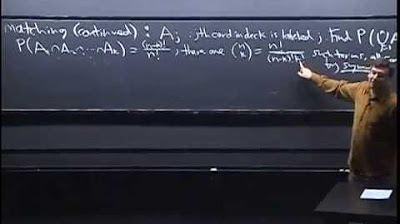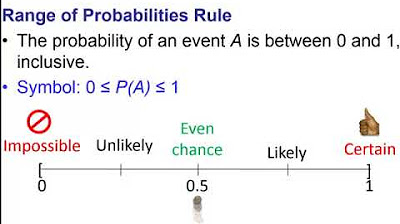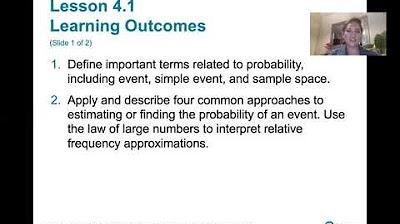Lecture 2: Story Proofs, Axioms of Probability | Statistics 110
TLDRThe speaker provides a comprehensive overview of key concepts and strategies for approaching homework and exams in a course that delves into probability and combinatorics. Emphasizing the importance of common sense, the speaker advises students to use calculators judiciously and to simplify answers where possible. The concept of 'self-annotating' is introduced as a method to avoid confusion when dealing with complex problems. The speaker also highlights the significance of checking answers through special cases and alternative methods to ensure accuracy. The use of labels for clarity in problem-solving is another crucial point made, with examples given to illustrate the potential pitfalls of not distinguishing between different elements in a problem. The lecture touches on the subtleties of distinguishable and indistinguishable items in probability, and the importance of considering the context when applying the naive definition of probability. The speaker concludes with a discussion on the non-naive definition of probability, introducing the concept of a probability space and its two fundamental axioms, which form the basis for all subsequent probability theorems and results.
Takeaways
- 🧐 Don't Lose Common Sense: While relying on common sense is important, it should not be the only guide, especially when dealing with counterintuitive results in the course.
- 📐 Use Reasonable Methods: Calculators can be used for homework but are not necessary for most parts. On exams, they are not allowed and not needed, emphasizing the importance of common sense and reasonable methods.
- 🔢 Self-Annotate Your Work: Leaving expressions like '52 choose 5' can be beneficial as it forces you to think about the problem in terms of combinations, which is a form of self-annotation.
- ✅ Check Answers: Verify your answers by trying special cases or alternative methods to ensure your solution is correct, which can help detect mistakes and reinforce understanding.
- 🏷️ Labeling is Key: Assigning labels or IDs to objects or people in a problem can greatly help in avoiding confusion and ensuring clarity in your problem-solving process.
- 💡 Look for Patterns: Recognizing patterns and structures in problems can lead to simpler solutions and a deeper understanding of the concepts involved.
- 📉 Simplify When Possible: For expressions like 4 divided by 2 times 1, it's preferred to simplify the answer to the most straightforward form, which in this case is 2.
- 🤔 Think About Indistinguishability: In probability, treat indistinguishable items as if they are distinguishable; this can lead to the correct answers in counting problems.
- 📚 Study Simple Nontrivial Examples: Examining the simplest nontrivial cases can provide valuable insights and help in understanding more complex scenarios.
- 📈 Use Story Proofs: Employing story proofs or interpretation proofs can make understanding and remembering mathematical identities and concepts easier than pure algebraic manipulation.
- 🚀 Beyond Naive Probability: Moving to a non-naive definition of probability involves considering a probability space with a sample space (S) and a probability function (P), which assigns probabilities to events that are subsets of S.
Q & A
What is the importance of using common sense in the course, and how does it relate to counterintuitive results?
-Common sense is crucial for maintaining a basic understanding and sanity check on answers, even though the course will encounter many counterintuitive results. It doesn't mean abandoning common sense when dealing with such results, but rather using it to stay grounded while exploring complex concepts.
Why might calculators be unnecessary for most of the homework, and what is the policy on calculators during exams?
-Calculators are generally unnecessary for most homework because the problems are designed to be solvable with basic arithmetic. On exams, calculators are neither allowed nor needed, emphasizing the importance of understanding and mental computation over computational tools.
What is the concept of 'self-annotating' expressions in the context of the homework problems?
-Self-annotating expressions refer to mathematical expressions that inherently provide context or meaning about what they represent. For instance, '52 choose 5' immediately conveys that the problem involves choosing 5 items from a set of 52, which can be more informative than just providing a large numerical result.
How can checking answers be effectively done, and what is the significance of using special cases?
-Checking answers is not about simply redoing the work; it involves trying different methods or special cases to verify the result. Using simple and extreme cases can often reveal errors or provide a deeper understanding of the problem.
What role does labeling play in solving problems, and why is it considered useful?
-Labeling is a technique to assign identifiers to objects or people in a problem, which can clarify complex situations and prevent confusion, especially when dealing with groups or collections. It helps in distinguishing between different elements and can simplify the process of solving problems.
How does the concept of distinguishable and indistinguishable items affect the way we approach probability problems?
-The concept is crucial as it changes the way outcomes are counted. Distinguishable items require considering each specific arrangement, while indistinguishable items are treated as identical, which can significantly reduce the number of outcomes and thus affect the probability calculations.
What is the difference between splitting 10 people into a team of 4 and a team of 6, versus two teams of 5?
-When splitting into a team of 4 and a team of 6, there is a clear distinction between the two teams, so each division is unique. However, with two teams of 5, without additional distinguishing features, any arrangement of the two teams is considered equivalent, leading to a division by 2 to account for overcounting.
Why is it important to consider the order of selection in certain probability problems?
-The order of selection can matter when there are specific roles or designations within the selection, such as choosing a president for a committee. In contrast, when the order of selection does not affect the outcome, such as when drawing without replacement where order doesn't matter, it simplifies the counting process.
What is the general formula for the number of ways to draw k times with replacement from a set of n objects when order doesn't matter?
-The general formula for this scenario is n plus k minus 1 choose k, which accounts for the number of ways to draw k items with replacement from a set of n objects when the order of drawing does not affect the outcome.
How does the concept of counting using labeled and unlabeled items apply to the problem of drawing from two indistinguishable buckets?
-When items are indistinguishable, as in the case of the two buckets, the focus is on the number of items in each bucket rather than specific item identities. This simplifies the counting process to determining the distribution of 'dots' (items) across the 'boxes' (buckets).
What is the significance of the non-naive definition of probability, and how does it differ from the naive definition?
-The non-naive definition of probability allows for a more general approach that doesn't assume equally likely outcomes or a finite number of outcomes. It introduces the concept of a probability space, which consists of a sample space and a probability function that assigns probabilities to events (subsets of the sample space), adhering to the axioms of probability.
Outlines
📚 Emphasizing Common Sense in Problem Solving
The speaker begins by stressing the importance of using common sense when approaching homework problems, while acknowledging that the course will cover counterintuitive results that may challenge this sense. They clarify that common sense should not be abandoned, but rather balanced with an understanding that calculators can be used for complex problems on homework, but not on exams. The concept of 'self-annotating' expressions is introduced, where leaving answers in a form that inherently explains the problem, such as '52 choose 5', is encouraged over simply computing a numerical result. The speaker also advises against tedious calculations, suggesting that if a problem seems overly complex, a different approach may be necessary. They conclude with the advice to check answers through different methods and to use simple or extreme cases to verify the correctness of solutions.
🔍 The Power of Labeling in Problem Solving
The speaker moves on to discuss the utility of labeling in problem-solving, emphasizing its importance in avoiding confusion, especially when dealing with objects or entities that may seem identical. They provide examples involving people, elk, gummy bears, and balls in a jar to illustrate how assigning an ID or label can clarify complex problems. The speaker also touches on the distinction between distinguishable and indistinguishable items in the context of probability, using the example of robberies and districts to illustrate the concept. They clarify a homework problem regarding the division of people into teams and explain the mathematical reasoning behind the solution, highlighting the importance of understanding the difference between distinguishable and indistinguishable elements in such scenarios.
🤔 The Importance of Thinking Through Problems
The speaker delves into the nuances of problem-solving, stressing the need to think through problems carefully and not to rely solely on the naive definition of probability. They introduce a scenario involving the selection of objects from a set with replacement and where order does not matter, aiming to calculate the number of ways this can occur. The speaker suggests verifying the plausibility of solutions by checking simple and extreme cases, such as when k equals 0, and explains the rationale behind the selection process in these scenarios. They also touch on the importance of recognizing patterns and structures in problems, noting that two seemingly different problems can be equivalent and should be approached as such.
📝 Understanding Counting and Probability Through Stories
The speaker explores the concept of 'story proofs' as a method for understanding and proving mathematical identities, using the example of counting the ways to choose k people out of n with one designated as president. They illustrate how this can be calculated in two different ways, both resulting in the same outcome, thus providing a proof. The speaker emphasizes the value of interpretation over mere algebraic manipulation for better understanding and retention of mathematical concepts. They also introduce Vandermonde's identity as a significant mathematical concept that is more accessible through a story-based explanation rather than a purely algebraic one.
🧮 Introducing the Non-Naive Definition of Probability
The speaker concludes the script by transitioning to the non-naive definition of probability, moving beyond the assumptions of equally likely outcomes and finite possibilities. They introduce the concept of a probability space, which consists of a sample space (S) and a probability function (P). The sample space is the set of all possible outcomes, while the probability function assigns a number between 0 and 1 to each event (subset of S). The speaker outlines the two axioms that the probability function must satisfy: the probability of the empty set is 0, and the probability of the entire sample space is 1. They express amazement at the simplicity of these axioms, given the complexity of probability theory, and indicate that all theorems and results in probability can be derived from them.
Mindmap
Keywords
💡Common Sense
💡Calculators
💡Counterintuitive
💡Self-annotating
💡Checking Answers
💡Labeling
💡Indistinguishable Objects
💡Sampling with Replacement
💡Naive Definition of Probability
💡Vandermonde's Identity
💡Probability Space
Highlights
The importance of maintaining common sense while approaching problems, even when encountering counterintuitive results.
The suggestion that calculators should not be necessary for most homework problems, with the exception of specific parts where they are obviously needed.
Clarification that exams will not allow calculators and will not require them, emphasizing the use of common sense.
The concept of 'self-annotating' expressions, such as '52 choose 5', which inherently provide context about the problem.
Advising students to simplify expressions like 4 divided by 2 times 1 to 2, as part of using common sense in problem-solving.
The strategy of checking answers by trying special cases and considering alternative methods to solve problems.
The usefulness of labeling objects or people in problems to avoid confusion and to think more clearly about the problem structure.
The distinction between distinguishable and indistinguishable items in probability problems and how it affects the approach to solving them.
The clarification on how to approach problems involving splitting groups into teams, emphasizing the difference between teams of different sizes versus equal-sized teams.
The explanation of the multiplication rule and its application in counting problems, such as the number of ways to pick teams from a group of people.
The introduction of the naive definition of probability and its limitations, stressing the need to ensure equally likely outcomes when applying it.
The exploration of the concept of story proofs as a method to understand and remember mathematical identities, such as Vandermonde's identity.
The illustration of the non-naive definition of probability, moving beyond the assumption of equally likely outcomes and finite sample spaces.
The axioms of probability, which include the probability of the empty set being 0 and the probability of the full sample space being 1.
The countable additivity axiom, which states that the probability of the union of non-overlapping events equals the sum of their probabilities.
The emphasis on the simplicity of the axioms of probability, which form the basis for all subsequent theorems and results in the field.
The practical application of these concepts in various areas of mathematics and physics, including the prediction of the Bose-Einstein condensate.
The advice to draw diagrams and try simple examples when faced with complex counting problems, to gain a better understanding of the underlying patterns.
Transcripts
Browse More Related Video

Lecture 1: Probability and Counting | Statistics 110

Lecture 3: Birthday Problem, Properties of Probability | Statistics 110

Lecture 4: Conditional Probability | Statistics 110

2022 Live Review 2 | AP Statistics | Making Sense of Probability & Random Variables

Chapter 4 Probability Part 1

4.1.0 Basics of Probability - Lesson Overview, Key Concepts and Learning Outcomes
5.0 / 5 (0 votes)
Thanks for rating: